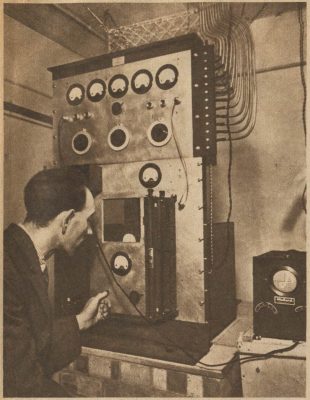…where east meets west
- Home
- Brief History
- The Greenwich Meridian
- Greenwich
(1675–1958) - Herstmonceux
(1948–1990) - Cambridge
(1990–1998) - Outstations (1822–1971)…
- – Chingford (1822–1924)
- – Deal
(1864–1927) - – Abinger
(1923–1957) - – Bristol & Bradford on Avon
(1939–1948) - – Bath
(1939–1949) - – Hartland
(1955–1967) - – Cape of Good Hope
(1959–1971)
- Administration…
- – Funding
- – Governance
- – Inventories
- – Pay
- – Regulations
- – Royal Warrants
- Contemporary Accounts
- People
- Publications
- Science
- Technology
- Telescopes
- Chronometers
- Clocks & Time
- Board of Longitude
- Libraries & Archives
- Visit
- Search
The Quartz Clock, Q3, installed at Greenwich in 1939 and re-erected at Abinger in 1943
page under construction
Location of the clock and batteries at Greenwich

George Rickett with the newly delivered quartz clock Q3 in 1939. The small plate above the central dial at the top of the instrument is inscribed 'N.P.L. Quartz Clock No. 3 ...'. From the 24 February 1946 edition of Le Patriote Illustré
t was the ability of the cellars to provide a stable temperature together with their massively constructed walls that lead to the clocks themselves being mounted in them. But this wasn’t until 1924, when one of the two main cellars was adapted to house the new standard clock - Shortt 3.
In 1938/9, Spencer Jones’ larder (a bathroom in Airy’s time) was divided to accommodate batteries for the regular time service and also the high capacity cells required to provide the current for the recently introduced quartz clock in the event of an interruption to the mains supply. The new Battery Room occupied the northern half of the converted larder. The clock itself was placed on a specially built brick plinth (which still survives) in the small cellar beneath the Octagon Room stairs that had previously been used as the battery room extension. The clock was relocated to Abinger in 1943.
© 2014 – 2025 Graham Dolan
Except where indicated, all text and images are the copyright of Graham Dolan